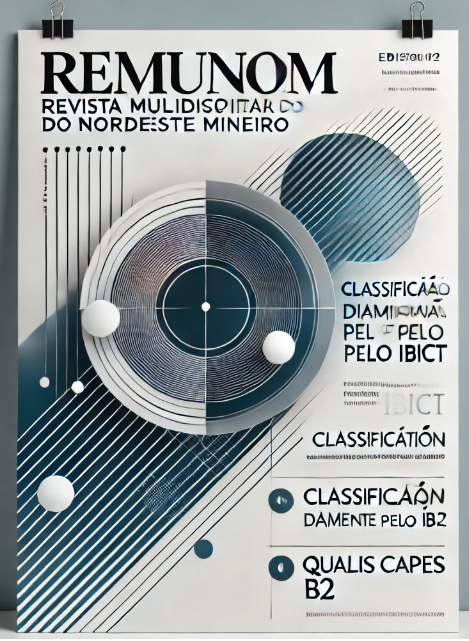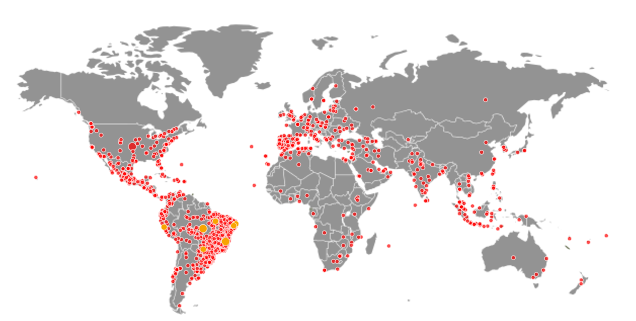SPATIAL-TEMPORAL CHARACTERIZATION OF LAND USE VARIATION BETWEEN 1985 AND 2022 IN THE PIRANGA RIVER BASIN IN MINAS GERAIS
DOI:
https://doi.org/10.61164/rmnm.v5i1.3622Keywords:
Sistema de Informações Geográficas; MAPBIOMAS; rede hidrográfica.Abstract
The dynamics of land use over time in river basins are crucial for understanding the factors that influence their variation and water availability. The Piranga River basin, an important tributary of the Doce River, is characterized by extensive areas of livestock farming and agriculture—activities that contribute to deforestation, increased erosion, and siltation of rivers. The primary objective of this study was to identify land use changes in the Piranga River basin in Minas Gerais between 1985 and 2022 and correlate them with variations in flow and rainfall patterns, using data from fluviometric stations and precipitation records. The methodology involved the use of geoprocessing and remote sensing tools, including images from MAPBIOMAS and vectors. The results revealed that, over the past four decades, the average annual land cover consisted of 29% native vegetation, 55% pastures, and 14% agriculture. Additionally, climatological normal data indicated no significant change in the rainfall pattern, but the flow rate of the Piranga River showed a declining trend over time. This trend may reflect poor land management, resulting in soil compaction and erosion, which increase surface runoff and reduce water infiltration. This situation exacerbates high flows during heavy rainfall events (floods) and diminished low flows during dry periods (leading to unsupplied water tables and spring droughts). The spatiotemporal analysis of imagery and hydrological data demonstrated that the economic management of land over the years has contributed to water imbalance in the basin. By highlighting the impacts of these changes, the study advocates for the adoption of sustainable land use practices, along with measures to restore degraded areas, particularly riparian forests and spring protection.
References
ANA. Agencia Nacional de Águas. Catálogo de Metadados da ANA. Bacias Hidrográficas Ottocodificadas (Níveis Otto 1-7). Brasília, 2024a. Disponível em: https://metadados.snirh.gov.br/geonetwork/srv/api/records/b228d007-6d68-46e5-b30d-a1e191b2b21f. Acesso em: novembro 2024.
ANA. Agencia Nacional de Águas. Dados estações fluviométricas - HIDROWEB Series históricas de estações ANA. 2024b. Disponível em: https://www.snirh.gov.br/hidroweb/serieshistoricas . Acesso em out 2024.
CBH – Comitê da Bacia Hidrográfia do Rio Piranga. Plano de ação de recursos hídricos da unidade de planejamento e gestão dos recursos hídricos Piranga (parh piranga). Ebook. 2010. 127p. Disponível em: https://www.cbhdoce.org.br/wp-content/uploads/2014/10/PARH_Piranga.pdf. Acesso em janeiro 2024.
GARCIA DE SOUSA, R., MARTINS, L., SOARES NUNES, F., & BERNARDES SILVA, F. Análise da precipitação, vazão, uso e cobertura da terra na bacia do rio São João/Mg. Revista Augustus, 24(49), 146–154, 2019. DOI: https://doi.org/10.15202/1981896.2019v24n49p146.
HOFFMANN, G. P., & NANNI, A. S.. O uso da terra e sua influência sobre o volume das águas na Bacia do Rio Biguaçu/SC. Geosul, 32(63), 97, 2017. DOI: https://doi.org/10.5007/2177-5230.2017v32n63p97.
INMET. Instituto Nacional de Meteorologia. Normais climatológicas do Brasil. 2024. Disponível em: https://portal.inmet.gov.br/normais# .
JUNQUEIRA J., J.A.; MELLO, C.R.; SILVA, A.M. comportamento hidrológico de duas nascentes associadas ao uso do solo numa sub-bacia hidrográfica de cabeceira. XVI Congresso Brasileiro de Águas Subterrâneas e XVII Encontro Nacional de Perfuradores de Poços. 2010. Anais. Disponível em: https://aguassubterraneas.abas.org/asubterraneas/article/view/22966. Acesso em março 2020.
MAPBIOMAS. Projeto MapBiomas – Coleção 7 - publicada em agosto de 2022, com 27 classes de legenda cobrindo o período de 1985 - 2021. Disponível em: < https://mapbiomas.org/produtos >. Acesso em 23 novembro 2022.
MORAES, R.A.; NASCIMENTO, A.T.A. Análise temporal do uso e cobertura do solo na bacia hidrográfica do Rio Piracicaba em Minas Gerais. Geoambiente On-line, n. 38, p. 19-37, 2020.
MOREIRA, Mauricio. A. Fundamentos do Sensoriamento Remoto e Metodologias de Aplicação. 3ª ed. Viçosa/MG: UFV, 320p, 2007.
NASCIMENTO, R. A.; CASTRO, J.F.M. Análise climatológica da Bacia do Rio Piranga - MG: (1951 - 2012). Geografia e Pesquisa (UNESP. Ourinhos), V. 7 , P. 79-99 , 2013.
QGIS Development Team. QGIS Geographic Information System. Open Source Geospatial Foundation Project. 2023. Disponível em: http://qgis.osgeo.org.
TUCCI, C.E.M.; CLARKE, R.T. Impacto das mudanças da cobertura vegetal no escoamento: revisão. RBRH – Revista Brasileira de Recursos Hídricos, v.2, n.1, Jan/Jun 1997, p.135-152. 1997. DOI: 10.21168/rbrh.v2n1.p135-152.
Downloads
Published
How to Cite
Issue
Section
License
Copyright (c) 2025 Revista Multidisciplinar do Nordeste Mineiro

This work is licensed under a Creative Commons Attribution-NonCommercial-ShareAlike 4.0 International License.




